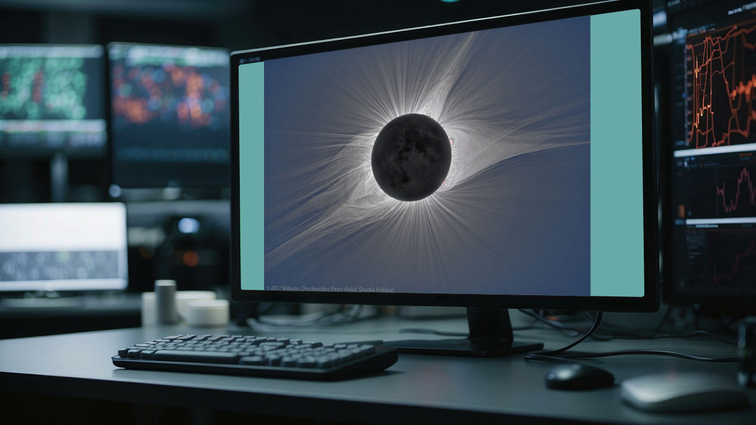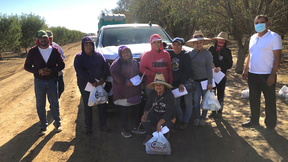See the solar corona: an intricate pattern reveals itself during the April 8 eclipse
 (Download Image)
(Download Image)
A photograph of the corona taken during the Aug. 21, 2017, total solar eclipse. (Photo credit: Miloslav Druckmüller, Peter Aniol, Shadia Habbal/NASA Goddard, Joy Ng. Graphic credit: Amanda Levasseur).
On Monday, April 8, a swath of North America will experience a total solar eclipse. For a few minutes, the moon will completely obscure the sun and viewers will be able to see the intricate loops and flares in the solar corona—normally washed out by the bright disk of the sun.
In the corona, the outermost, gaseous part of the sun’s atmosphere, particles dance around invisible magnetic field lines to make complex structures. Imagine the particles like cars racing through a city, merging onto highways and roundabouts, turning onto side streets and stopping at traffic lights. But the magnetic field “roads” in the corona are invisible, creating a beautiful, chaotic, hard-to-decipher pattern of particles.
Since the 1980s, researchers at Lawrence Livermore National Laboratory (LLNL) have been unraveling the patterns in the solar corona using a device called an electron beam ion trap (EBIT).
“In astronomical objects like the Sun, there are a lot of things going on at the same time. You have emission from all these different ions and atoms,” said Alex Fairchild, a postdoctoral researcher at LLNL. “In the laboratory setting we can disentangle processes that occur simultaneously in the corona. We can measure and identify emission from a single ion species.”
To accomplish this, Fairchild and his collaborators use a series of electric and magnetic fields to create a dense stream of electrons and aim it at target atoms like silicon or iron. The resultant collisions ionize and excite the atoms, which release their extra energy in the form of ultraviolet (UV) and X-ray light.
By examining the emission, LLNL scientists can test models of the sun and help interpret solar observations. They use this information to assist solar physicists with determining the temperature and density of the solar corona.
Understanding the solar corona becomes crucial as the number of satellites in space increases. Flares and solar wind material ejected from the sun’s atmosphere affect space weather, which can interfere with satellites and GPS.
There’s also a long-standing fundamental physics problem: coronal heating.
“The sun’s corona is actually much hotter than its surface, which is a bit counterintuitive,” said Fairchild. “This is like if a light bulb raised the temperature of the surrounding air to a temperature much hotter than the light bulb itself. We don’t completely understand how the solar atmosphere at higher elevations, where we expect it to be colder, is so hot.”
“If you’re interested in this kind of work, LLNL is one of the best places to be,” said Fairchild.
LLNL’s EBIT-I and SuperEBIT electron beam ion traps have been used for over three decades to help answer questions related to solar physics, astrophysics, and fusion science.
Find more information here about LLNL’s EBIT laboratory astrophysics work. For more information about LLNL’s space science efforts visit the Space Science Institute website.
The eclipse’s path of totality begins in Mexico, and the path of totality will pass through Texas, Oklahoma, Arkansas, Missouri, Illinois, Kentucky, Indiana, Ohio, Pennsylvania, New York, Vermont, New Hampshire and Maine. Those outside the path of totality can still catch a partial solar eclipse. Anyone looking at the sun should use proper safety glasses. View the eclipse timing by location here.
–Ashley Piccone
Contact
 Michael Padilla
Michael Padilla
[email protected]
(925) 341-8692
Related Links
X-ray and laboratory astrophysicsA hub for space science research at LLNL
Eclipse Calculator
Tags
Physical and Life SciencesPhysics
Space Science Institute
Featured Articles








